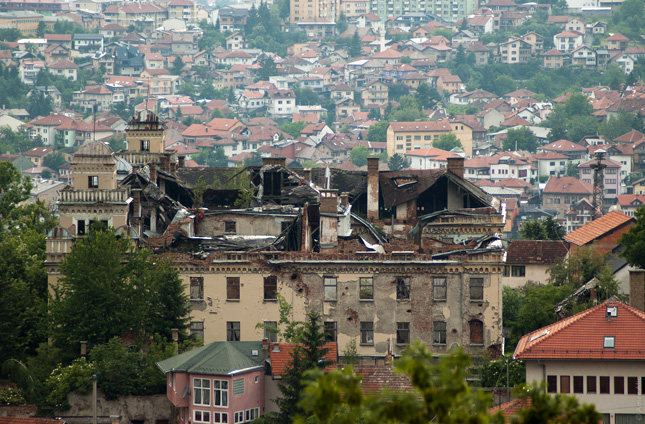-
Forecasting Development: Observations From Scenario Planning for Bosnia and Herzegovina
April 5, 2016 By Carolanne Chanik
I’m planning a road trip and I want to know what to pack. I could rely on what I’ve learned from past trips or what it looks like out the window right now, but what would really help are a weather forecast and a guidebook telling me what I might expect. It’s no guarantee against a wrong turn or two, but it will certainly better prepare me for the road ahead and help me take advantage of opportunities along the way.
As it turns out, the U.S. Agency for International Development (USAID) is following a similar exercise to help nations lift people out of poverty using a tool called scenario planning. Scenario planning helps agency planners and mission officers escape from the demands of the now and think strategically about what may be coming down the road.
Not many of us foresaw the global financial crisis of 2008 or the current refugee crisis in Europe, but imagine if we had. We could have pushed USAID’s programming to be more adaptable to a wider set of possibilities and positioned nations to better respond to humanitarian disasters as well as exploit opportunities for growth and prosperity.
USAID’s Global Development Lab is the entity within the agency tasked with leading scenario-planning exercises. They help in-country missions and the agency as a whole develop more realistic and accountable strategic plans through improved adaptive programming. This February, I had the opportunity to take part in a scenario-planning workshop led by the lab for Bosnia and Herzegovina.
Tracking Trends
What I experienced was fascinating. USAID gathered 15 experts on Bosnia based in the United States for a one-day workshop to parse out alternative views on how this nation, still recovering from war along vicious ethnic and religious lines, might develop over the next 10 to 20 years.
The cone of possibilities widens as time gets further awayThe agency is moving away from fixed-in-stone strategic blueprints that assume just one future towards an approach that considers several and can be adapted along the way as new knowledge, insights, and emerging trends come to light. As part of the exercise, we began to flesh out the trends and factors that brought Bosnia to its present state and that could drive future scenarios.
Current figures show that the nation has been in a 10-year economic backslide, never quite recovering from the 2008 financial crisis. The unforeseen global collapse cost trillions of dollars worldwide and staunched any economic progress made in the aftermath of Bosnia’s 1992-1995 war.
Lack of country-led privatization efforts, a failing job market, sluggish-to-unresponsive government entities, long lasting ethno-cultural tensions, and educational divides were a few of the major issues we suspected would play a role in the nation’s trajectory. We also examined scenarios involving the hastened effects of climate change, a boost in local tourism, more fighters from the Balkans joining the Islamic State, and various European Union accession timelines.
Future Histories
However, the main purpose of the workshop was to develop “future histories” for the nation, which was no small task. Based on a set of internal and external drivers supporting and/or opposing a united Bosnia, we were split into four groups.
My group was tasked with thinking though a future history where both international forces and Bosnians themselves supported a unified nation – arguably the most positive, but also the most challenging scenario for which to plan around, considering current conditions. Keeping in mind present-day struggles, we had to figure out which forces would be strong enough to unite the fragmented people of Bosnia and the international community. After much debate, we felt European Union accession could be the strongest driving force of such a result.
A Syrian peace agreement could reduce the draw on radicalized youth and shift EU fundingRegional changes, such as a Syrian peace agreement – which could reduce the draw on radicalized youth and shift some European Union funding from the refugee crisis to development in Bosnia and its neighbors – may be enough to push the nation closer to peace and increased cohesion. Additionally, my group suspected that if Bosnians saw neighboring countries experiencing an improved quality of life from membership in the European Union, it might be enough to incentivize a national change for the better.
Of course this scenario almost certainly won’t come to pass exactly as we described, but working through it at least provides a set of benchmarks for the country and USAID to observe should we start down that path.
Getting myself into a future-focused mindset wasn’t easy. Planning 20 years out is much different than planning for tomorrow. The cone of possibilities widens as time gets further and further away. Something that seems impossible now, may be entirely possible in a decade or two.
Two weeks later, USAID held a similar workshop in Sarajevo to gather essential in-country perspectives on the drivers of change. The agency readily admits it cannot predict the future, but scenario planning and other “futures” tools, like horizon scanning, bolster its ability to partner with host countries to peer into an uncertain future and together consider the best development choices.
Carolanne Chanik is a communications associate at DAI supporting the U.S. Agency for International Development’s Global Development Lab.
Sources: DAI.
Photo Credit: A ruined building in Sarajevo, June 2013, courtesy of flickr user Amer.
 A Publication of the Stimson Center.
A Publication of the Stimson Center.



